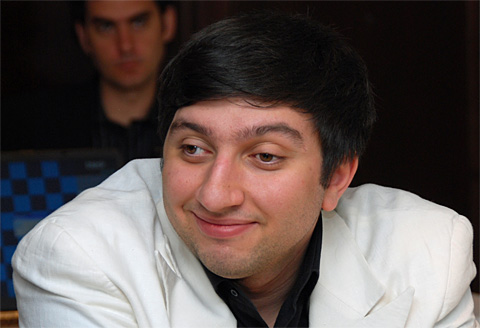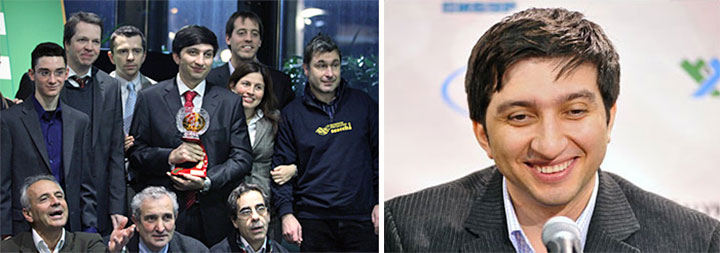


Vugar Gashimov was born on July 24, 1986 in Baku. The son of a retired army colonel, he started to show his creative talent as a chess player at a young age, finishing in second place at the World U10 Championship in 1996, behind Pentala Harikrishna, and representing Azerbaijan in European Team Championships as early as at age 15.
 In February 2000, he was diagnosed with epilepsy, and subsequently a brain tumor was found. He received treatment for over a decade and stopped playing professionally in early 2012. Elisabeth W, who had been his girlfriend and was with him to the end, said of Gashimov:
In February 2000, he was diagnosed with epilepsy, and subsequently a brain tumor was found. He received treatment for over a decade and stopped playing professionally in early 2012. Elisabeth W, who had been his girlfriend and was with him to the end, said of Gashimov:
Vugar was a level-headed person who always put more emphasis on the well-being of others than his own. He was a person with a great sense of beauty and aesthetics, a person, who could find joy in the simple things of life – always with a smile on his face. For him, happiness meant making other people happy. Vugar was a thoughtful person with a lot of interests: he was a person with an affinity for everything cultural, he composed poems and loved philosophizing about life, listening to music for hours on end, interpreting song lyrics, telling anecdotes, and playing tennis and FIFA on his computer.
His achievements in individual events include winning the 2005 Acropolis International Tournament, sharing first place at the Cappelle-la Grande Open in 2007 and 2008, winning the Category XVIII Reggio Emilia Tournament in 2010/11 and winning the first stage of the 2008 Grand Prix in Baku.
He represented Azerbaijan in four Chess Olympiads (from 2002 until 2008) and five European Team Championships (from 2001 until 2011). He won team gold and individual silver at the European tournament in 2009.
With a peak rating of 2761, he reached sixth place in the world rankings. He was also known for being a very strong blitz player.
A lot can be written about Gashimov’s contagious personality and his incredible skills as an uncompromising player (most notably, he revived the Benoni as a playable opening among the elite), but we will use this chance to remember three highlights from his chess career.
Gashimov was seeded into the 2008/10 Grand Prix as a host-city nominee. The first event of the series was played in his home town, Baku, and saw him sharing first place on 8/13 with Wang Yue and a 17-year-old Magnus Carlsen. The Azerbaijani finished the tournament undefeated, beating Alexander Grischuk, Peter Svidler and Gata Kamsky on his way to victory — although the GP points were shared with Carlsen and Wang, he was declared the winner on tiebreaks.
All three of his wins came with the white pieces and showcased his dynamic style. Most notably, against Grischuk in round 12, he played an extremely sharp opening line which he had prepared at home:
The game continued 14.Nc3 (ignoring the threat against the g5-knight) fxg5 15.Bxg5 Be7 16.f4. Gashimov noted at the press conference that it was all home preparation until his 16th move and said, “Before the game I thought White is much better, maybe even winning, after f4”. What followed was a delightful conversion into a 33-move win.
Replay all three of Gashimov’s victories from the tournament:
The second seeds from Azerbaijan won the event ahead of Russia, the favourites. What made this tournament so special for Gashimov was the last round. Sagar Shah gave a detailed account of what happened on October 30 in Novi Sad.
Russia and Azerbaijan were tied at 13 points before the final round — Russia was playing Spain while Azerbaijan was facing the Netherlands. Surprisingly, Ivan Salgado defeated Evgeny Alekseev to tie the score with Russia (Alexander Morozevich had beaten Paco Vallejo), so Azerbaijan would get the gold with a win — a draw would not be enough, as Russia had the better tiebreak score.
Teimour Radjabov, Shakhriyar Mamedyarov and Rauf Mamedov had drawn their games, so it would all be decided on Gashimov’s board. He had white against Daniel Stellwagen and came from wasting some winning chances in a rook endgame. But suddenly Stellwagen faltered on move 70:
Instead of keeping the balance with 70...Rb4, the Dutch grandmaster went for the losing 70...Rf4 and resigned after 71.Ke6 h4 72.f7 Kg6 73.f8Q Rxf8 74.Rxf8 Kg5 75.Ke5. White’s victory was effusively celebrated by his teammates (see video below).
Gashimov himself annotated the game:
Footage recorded by Europe-Echecs
Despite losing in the first round against Nigel Short, Gashimov went on to win the tournament with a 6/9 score. Paco Vallejo obtained the same +3 score but had a worse tiebreaker. Gashimov beat the local Michele Godena, Vassil Ivanchuk, Vallejo and David Navara. The latter three wins are here annotated:

Reggio Emilia 2010/11: Fabiano Caruana, Nigel Short, Alexander Onischuk, Vugar Gashimov, Francisco Vallejo Pons (standing behind WGM Martha Fierro), and Vassil Ivanchuk, with the tournament staff below